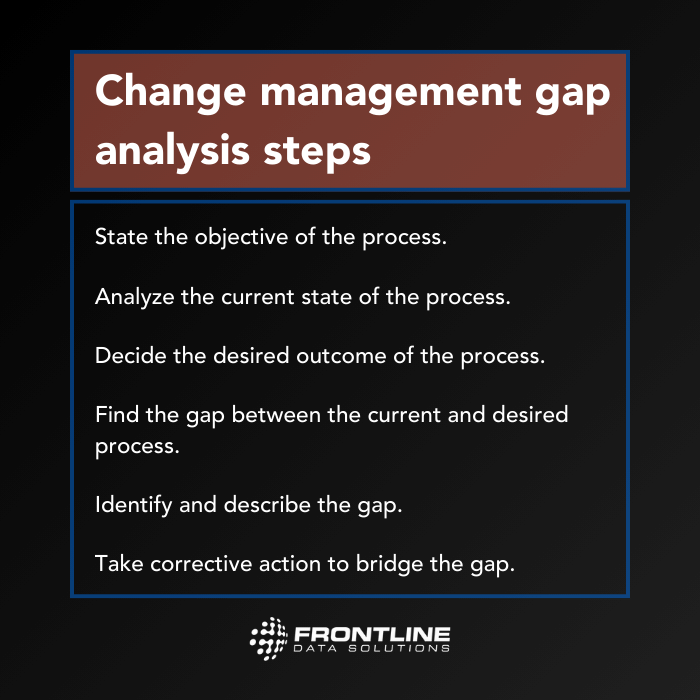If you have a change management process in place, then you’re already several steps ahead of the curve. But it’s not enough to implement a process and leave it alone. To improve performance, it’s important to consistently audit and adjust how you coordinate changes. Gap analysis can be a useful tool for identifying areas of improvement in your site’s change management process.
Change management gap analysis overview
The purpose of a change management gap analysis is to find weaknesses in your current process, so you can find the best approach moving forward. You can analyze your change management process by following the same basic steps of any gap analysis:
- State the objective of the process.
- Analyze the current state of the process.
- Decide the desired outcome of the process.
- Determine whether a gap exists between the current and desired processes.
- Identify and describe the gap.
- Take corrective action to bridge the gap.
There are so many potential blind spots in management of change. Employee turnover, interdepartmental communication, and regulatory compliance are just some of the factors that can quickly impact performance. Doing routine gap analyses is an easy way to ensure that your change management process is effective at reducing risk exposure and preventing incidents.
Examples of gaps in change management
Change management processes vary greatly from industry to industry. For example, the types of changes a manufacturing facility oversees are much different from those at an HR staffing company. The gaps you’ll find during your analysis will vary just as much, especially if you have a large or complex operation.
Here are some examples of gaps you might find in your change management process:
- Bottleneck in the change approval process
- Delay between when you receive and review change requests
- Poor documentation of change implementation
- Lack of oversight at the management level
- Insufficient pre-implementation planning
- Issues tracking implementation action items
- Lack of accountability and visibility over implementation tasks
- Failures in the change review process
Remember, a gap is any difference between where you’re at and where you want to be in the future. Most likely, you’ll never run out of gaps if you continue to innovate and grow as a company.

Tips for successful gap analysis
One of the biggest mistakes you can make is doing audits and assessments just to check a box. If you don’t have the time to do a full analysis, then just wait until you do. There’s absolutely no point in going through a gap analysis and either not going deep enough to find real issues or not following up with your findings.
Here are some things you can do to get more out of a change management gap analysis:
- Start with the change request process and end with the change monitoring process.
- Break down the process into the smallest steps you can, so you can find areas where it’s unnecessarily complicated or inefficient.
- Collect concrete data on the time it takes to process requests, implement changes, etc., for a better idea of efficiency.
- Get feedback from employees on recent changes you’ve completed.
- Analyze the effectiveness of past changes you’ve made.
- Review past changes and see whether workers still follow them or not.
Even if you perfected your change management process at some point, the variables always shift. There are always new people and new policies impacting how your company implements changes. Doing a gap analysis of your change management approach every few quarters is a great way to ensure that it remains effective and efficient over time.
Other posts you might like…
No posts

